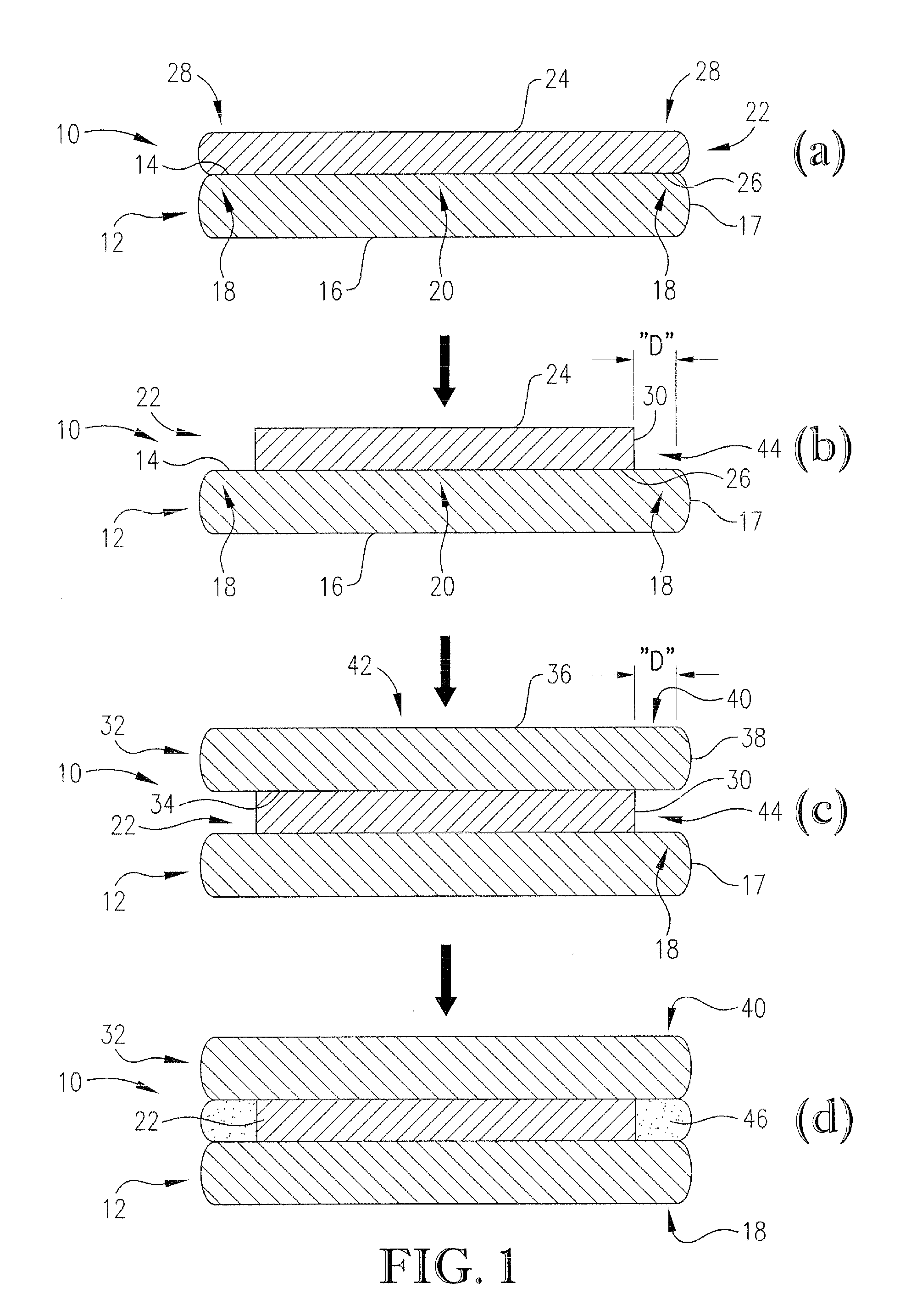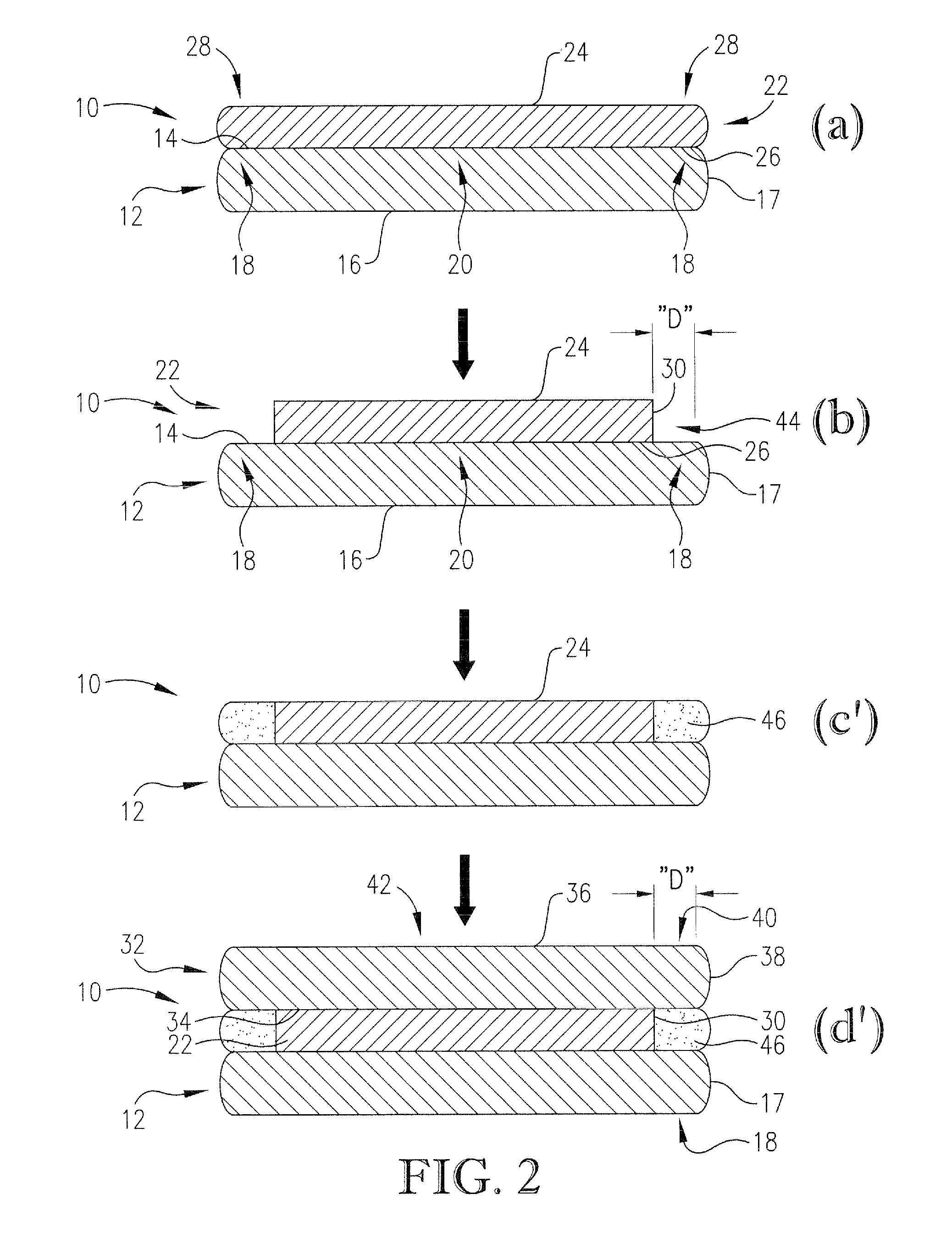Method for reversibly mounting a device wafer to a carrier substrate
a carrier substrate and device wafer technology, applied in the field of temporary wafer bonding methods, can solve the problems of high thermal and mechanical stress on the device wafer, the inability to form backside electrical contacts that connect with the front-side circuitry, and the thinned device wafers that have been less than 100 microns thinned,
- Summary
- Abstract
- Description
- Claims
- Application Information
AI Technical Summary
Benefits of technology
Problems solved by technology
Method used
Image
Examples
example 1
Edge Surface Adhesively Bonded and Center Surface Chemically Modified
[0075]An epoxy-based photoresist (SU-8 2002, Microchem, Newton, Mass.) was dispensed onto the surface of a 100-mm silicon wafer (wafer 1) at the outer edge to coat a section of the wafer surface that was about 3-5 mm wide. A fluorinated silane ((heptadecafluoro-1,1,2,2-tetrahydrodecyl)trichlorosilane) was diluted to a 1% solution using FC-40 solvent (perfluoro compound with primarily C12, sold under the name Fluorinert, obtained from 3M). The solution was spin coated onto the surface of wafer 1. The wafer 1 was baked on a hotplate at 100° C. for 1 minute. It was rinsed with FC-40 solvent in a spin coater and baked at 100° C. for an additional 1 minute. The epoxy-based photoresist was removed using acetone in a spin coater, leaving the edge untreated from the fluorinated silane solution.
[0076]The surface of another 100-mm silicon wafer (wafer 2) was coated with a bonding composition (WaferBOND® HT 10.10, available f...
example 2
Edge Surface Adhesively Bonded, Center Surface Chemically Modified, and Debonding Using Solvent Jet at Edge with Wedge
[0077]An epoxy-based photoresist was dispensed onto the surface of a 200-mm silicon wafer (wafer 1) at the outer edge to coat a section of the wafer surface that was about 3-5 mm wide. A fluorinated silane ((heptadecafluoro-1,1,2,2-tetrahydrodecyl)trichlorosilane) was diluted to a 1% solution using FC-40 solvent. The solution was spin coated onto the surface of wafer 1. The wafer 1 was baked on a hotplate at 100° C. for 1 minute. It was rinsed with FC-40 solvent in a spin coater and baked at 100° C. for an additional 1 minute. The epoxy-based photoresist was removed using acetone in a spin coater, leaving the edge untreated from the fluorinated silane solution.
[0078]The surface of another 200-mm silicon wafer (wafer 2) was coated with WaferBOND® HT10.10 bonding composition via spin coating. This wafer was baked at 110° C. for 2 minutes and 160° C. for 2 minutes. The ...
example 3
Edge Surface Adhesively Bonded and Center Surface Coated with Release Material
[0079]A negative epoxy-based photoresist (sold under the name SU-8 2010, obtained from MicroChem) was spin coated onto the surface of a 100-mm glass wafer. The wafer was baked at 110° C. for 2 minutes. A Teflon® AF solution (Teflon® AF2400 in FC-40, obtained from DuPont) was spin coated over the SU-8 2010. Then, FC-40 solvent was dispensed onto the surface of the wafer at the outer edge to remove about a 3-5 mm wide section of the Teflon® AF coating from the wafer surface. The wafer was baked at 110° C. for 2 minutes. The wafer was bonded in a face-to-face relationship with a blank, 100-mm silicon wafer under vacuum at 120° C. for 3 minutes in a heated vacuum & pressure chamber. The bonded wafers were exposed to broadband UV light from the outer side of the glass wafer. The exposed wafers were baked at 120° C. for 2 minutes to crosslink the SU-8 2010 coating. They were debonded by inserting a razor blade a...
PUM
| Property | Measurement | Unit |
|---|---|---|
| width | aaaaa | aaaaa |
| thickness | aaaaa | aaaaa |
| diameter | aaaaa | aaaaa |
Abstract
Description
Claims
Application Information
 Login to View More
Login to View More - R&D
- Intellectual Property
- Life Sciences
- Materials
- Tech Scout
- Unparalleled Data Quality
- Higher Quality Content
- 60% Fewer Hallucinations
Browse by: Latest US Patents, China's latest patents, Technical Efficacy Thesaurus, Application Domain, Technology Topic, Popular Technical Reports.
© 2025 PatSnap. All rights reserved.Legal|Privacy policy|Modern Slavery Act Transparency Statement|Sitemap|About US| Contact US: help@patsnap.com



